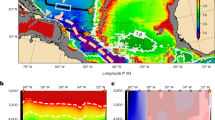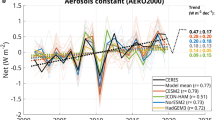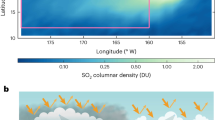Abstract
HUMAN activities have increased global emissions of sulphur gases by about a factor of three during the past century, leading to increased sulphate aerosol concentrations, mainly in the Northern Hemisphere. Sulphate aerosols can affect the climate directly, by increasing the backscattering of solar radiation in cloud-free air, and indirectly, by providing additional cloud condensation nuclei1–4. Here we use a global transport–chemistry model to estimate the changes in the distribution of tropospheric sulphate aerosol and deposition of non-seasalt sulphur that have occurred since pre-industrial times. The increase in sulphate aerosol concentration is small over the Southern Hemisphere oceans, but reaches a factor of 100 over northern Europe in winter. Our calculations indicate, however, that at most 6% of the anthropogenic sulphur emissions is available for the formation of new aerosol particles. This is because about one-half of the sulphur dioxide is deposited on the Earth's surface, and most of the remainder is oxidized in cloud droplets so that the sulphate becomes associated with pre-existing particles. Even so, the rate of formation of new sulphate particles may have doubled since pre-industrial times.
This is a preview of subscription content, access via your institution
Access options
Subscribe to this journal
Receive 51 print issues and online access
$199.00 per year
only $3.90 per issue
Buy this article
- Purchase on Springer Link
- Instant access to full article PDF
Prices may be subject to local taxes which are calculated during checkout
Similar content being viewed by others
References
Charlson, R. J., Langner, J. & Rodhe, H. Tellus A/B 43, 152–163 (1991).
Twomey, S. Atmospheric Aerosols (Elsevier, Amsterdam, 1977).
Charlson, R. J., Lovelock, J. E., Andreae, M. O. & Warren, S. G. Nature 326, 655–661 (1987).
Wigley, T. M. L. Nature 339, 365–367 (1989).
Zimmermann, P. H. in Proc. 16th NATO/CCMS int. Tech. Mtg Air Pollution Modeling and its Application, 593–608 (Reidel, Dordrecht, 1987).
Langner, J. & Rodhe, H. J. atmos. Chem. 13, 225–263 (1991).
Andreae, M. O. Mar. Chem. 30, 1–29 (1990).
Bates, T. S., Cline, J. D., Gammon, R. H., & Kelly-Hansen, S. R. J. geophys. Res. 92, 2930–2938 (1987).
Crutzen, P. J. & Zimmermann, P. H. Tellus A/B 43, 136–151 (1991).
Brimblecombe, P., Hammer, C., Rodhe, H., Ryaboshapko, A. & Boutron, C. F. in Evolution of the Global Biogeochemical Sulphur Cycle (eds Brimblecombe, P. & Lein, A. Y.) 77–121 (Wiley, Chichester, 1989).
Neftel, A., Beer, J., Oeschger, H., Zürcher, F. & Finkel, R. C. Nature 313, 611–613 (1985).
Hegg, D. A. Geophys. Res. Lett. 17, 21–65 (1990).
Sievering, H. et al. Atmos. Envir. A25, 1479–1487 (1991).
Kaufmann, Y. J., Fraser, R. S. & Mahoney, R. L. J. Clim. 4, 578–588 (1991).
Schwartz, S. E. Nature 336, 441–445 (1988).
Houghton, J. T., Jenkins, G. J. & Ephraums, J. J. (eds) Climate Change: The IPCC Scientific Assessment (Cambridge Univ. Press, Cambridge, 1990).
Wigley, T. M. L. & Raper, S. C. B. Nature 357, 293–300 (1992).
Henriksen, A. & Brakke, P. F. Envir. Sci. Technol. 22, 8–14 (1988).
Author information
Authors and Affiliations
Rights and permissions
About this article
Cite this article
Langner, J., Rodhe, H., Crutzen, P. et al. Anthropogenic influence on the distribution of tropospheric sulphate aerosol. Nature 359, 712–716 (1992). https://doi.org/10.1038/359712a0
Received:
Accepted:
Issue Date:
DOI: https://doi.org/10.1038/359712a0
This article is cited by
-
Characterization of Rome’s rainwater in the early of 2018 aiming to find correlations between chemical-physical parameters and sources of pollution: a statistical study
Journal of Atmospheric Chemistry (2021)
-
Mineral dust and NOx promote the conversion of SO2 to sulfate in heavy pollution days
Scientific Reports (2014)
-
Impacts of intercontinental transport of anthropogenic fine particulate matter on human mortality
Air Quality, Atmosphere & Health (2014)
-
Chemical composition of precipitation and its sources in Hangzhou, China
Environmental Monitoring and Assessment (2011)
Comments
By submitting a comment you agree to abide by our Terms and Community Guidelines. If you find something abusive or that does not comply with our terms or guidelines please flag it as inappropriate.



